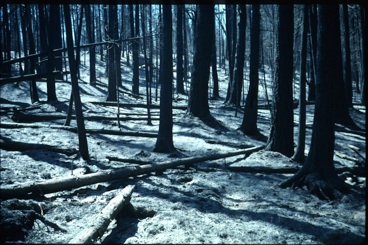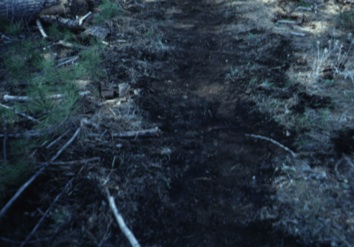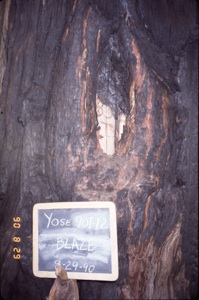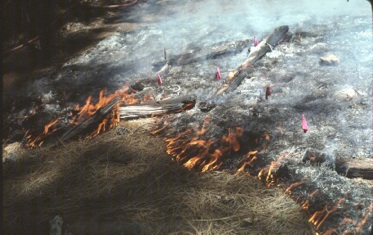

The effects of fire on cultural resources can be divided into direct, indirect, and operational effects.
Direct Effects are those caused by the fire itself. These are caused by either direct contact with flames, being in close proximity to heat produced by combustion or smoke effects.
Indirect Effects are those caused by the change in the soil stability and vegetation following the fire.
Operational/Suppression Effects are the result of management operations like line construction or staging.
The National Interagency Fire Center provides the a basic overview of Effects of Wildland Fire on Cultural Resources




Updated January 3, 2009

Two Field Office Fire Effects Bibliographies
Archaeological Sites and Fire-Induced Changes
Fire and Heritage Bare Bones Guide to Fire Effects on Cultural Resources Bureau of Land Management, Kate Winthrop, kate_winthrop@blm.gov
Fire and Archaeology by Larry Swan and Charla Francis Presented at the Symposium on Fire and Watershed Management, October 26-28, 1988,Sacramento, California. page 156
N.d. Effects of Wildland Fire on Cultural Resources.
The Archaeology of Volcan Mountain: Fire Management
Mesa Verde Archaeology and Fire
Ahler, S. A., Picha, P. R., Sayler, R. D., and Seabloom, R. W., Effects of Prairie Fire on Selected Artifact Classes. Annual Meeting of the Society for American Archaeology, 1990.
Ahler, S. A., Picha, P. R., Seabloom, R. W., and Sayler, R. D., Impacts of Prescribed Burning on Selected Cultural Resources., the 47th Plains Anthropological Conference, Sioux Falls, South Dakota, 1989.
Bayer, C., 1979. The Chalone Creek/South Pinnacles Prescribed Burn, Initial Archaeological Investigations.
Bennett, P. S., and Kunzmann, M., 1985. Effects of Heating on Artifacts: A Brief Report of Work Conducted at Western Archaeological Center, Tucson.
Biswell, H. H., 1989. Cultural Resources. In: Biswell, H. H., (Ed., Prescribed Burning in California Wildlands Vegetation Management. University of California Press, Berkeley, pp. 213-220.
Biswell, H. H., and Agee, J. K., 1999. Prescribed burning in California wildlands vegetation management. University of California Press, Berkeley. ,
Brown, G. B., and Folb, L., 1996. West Mesa and Walnut Canyon Burn Archaeological Survey Report. Submitted to U.S. Department of Interior, National Park Service, 2717 N. Steves Blvd. Suite 3, Flagstaff, AZ 86004.
Brown, J. K., Smith, J. K., and Lyon, L. J., 2000. Wildland fire in ecosystems: effects of fire on flora. U.S. Dept. of Agriculture Forest Service Rocky Mountain Research Station, Fort Collins, Colo. (240 W. Prospect Rd., Fort Collins 80526-2098).
Buenger, B. A., Reardon, J., and Ryan, K. C., Laboratory Wildland Fire Simulation and the Effect of Heating on Archaeological Materials. 68th annual Society of American Archaeology Conference, Milwaukee, Wisconsin, 2003.
Clay, V., Drews, M. P., Ingbar, E., and Zeier, C., 2004. An Examination of Fire Effects on Prehistoric Period Cultural Resources in Nevada.
Deal, K., Fire Effects Studies on the Eldorado National Forest. SCA Newsletter 36, 37-40.
Deal, K., Singed, Scorched and Torched: A Summary and Synthesis. Paper presented at Annual Meeting of the Society of American Archaeology, Denver, Colorado, 2002.
DeBano, L. F., Neary, D. G., and Efolliett, F., 1998. Cultural Resources. In: DeBano, L. F., Neary, D. G., and Efolliett, F., (Eds.), Fire Effects on Ecosystems. Wylie and Sons, New York, pp. 266-283.
Donaldson, B., 1982. Response to CRMWO Information Request Dated 9/7/82 on Potential Fire Effects on Cultural Resources.
Duncan, F. L., 1990. Fire Effects and Cultural Resources: An Annotated Bibliography. Mesa Verde National Park. Division of Research and Cultural Resource Management.
Edwards, J. L., 1995. Cultural Resources Survey of High-risk Areas Burned During the 1994 Fire Season, Fort Hunter Liggett Military Installation, Monterey County, California. BioSystems Analysis, Santa Cruz, California.
Elliott, Michael, Michelle Ensey, Elizabeth Oster, Samantha Ruscavage-Barz and Lisa Schub The Dome Fire Archeology Project of 1996-1997: Cultural Resources Damage Assessment and Treatment, National Park Service and New Mexico Historic Preservation Division
This volume describes archeological site damage assessment and treatment conducted following the Dome Fire of 1996 which burned approximately 4,000 acres at Bandelier National Monument and affected 515 archeological sites. This study incorporated an innovative methodology that measured fire severity on cultural sites using the ecosystem variables employed by the fire community and linked severity measurements to observed damage to site features and artifacts. Following site assessments, treatments were developed, applied and monitored for one year following the fire. The study offers the methodology used to assess 515 archeological sites and describes treatment of 56 damaged archeological sites. The authors also present the results of monitoring and subsequent evaluation of erosion control treatments.
Foster, D. G., N.d. Lesson Plan for 'Unit 8: Cultural Resources",.
Gauthier, R. P., 2007. Fire Effects on Archaeological Sites in the Southwestern USA: Preservation Issues and Treatments, 4th International Wildland Fire Conference, Seville, Spain. http://www.fire.uni-freiburg.de/sevilla-2007/contributions/doc/SESIONES_TEMATICAS/ST8/Gauthier_USA.pdf
Green, D. F., 1980. Managing fire effects Unit II C-2: Cultural resources. National Interagency Fire Training Center, USFS, pp. 1-12.
Halford, K., 2001. Fire Effects on Cultural Resources A Bibliographic Survey of Specific and Related Literature. Bureau of Land Management Bishop Field Office.
Hamby, C., and Holmquist, J. L., 2000. Burning Issues: Field Notebook - Student's Edition. Bureau of Land Management and the Interactive Media Science Project at Florida State University, Tallahassee.
Hanes, R., 2001. Cultural Resources. In: Group, N. W. C., (Ed., Fire Effects Guide. National Interagency Fire Center, Boise, ID, pp. Chapter VIII.
Hartford, R. A., and Frandsen, W. H., 1992. When It’s Hot, It’s Hot…or Maybe Not! (Surface Flaming May Not Portend Extensive Soil Heating). International Journal of Wildland Fire 2, 139-144.
Hemry, L., 1995. Appendix 3. Green Basin: Studying the Effects of Springtime Burns on Cultural Material. In: Hemry, L., Timmons, R., Hvizdak, R., Webster, C., Thoms, A., and White, M., (Eds.), A Management Strategy and Study of Prescribed Burning Impacts on Heritage Resources in Ponderosa Pine/Douglas-fir Composition Types on the Kootenai National Forest, Northwestern Montana. USDA Forest Service, Northern Region, pp. 1-10.
Henderson, R. A., and Statz, S. H., 1995. Bibliography of Fire Effects and Related Literature Applicable to the Ecosystems and Species of Wisconsin. Wisconsin Department of Natural Resources, Madison.
Hester, J. J., 1989. Effects of Forest Fires and Burn Programs on Archeological Resources, Archeological Sites Protection and Preservation Notebook Technical Notes, ASPPN I-8. US Army Engineer Waterways Experiment Station, Environmental Laboratory, Vicksburg, Mississippi.
Jackson, R. J., 2002. Programmatic Agreement Among the Advisory Council on Historic Preservation, The National Conference of State Historic Preservation Officers, The United States Department of Agriculture, and the United States Department of Interior Regarding the Treatment of Historic Properties that may be affected by Federal Fire Management Activities.
Jackson, R. J., c. 2002. Guidelines for the Development of Cultural Resource Management Protocols for Fuels Management Projects.
Jones, A. T., 2000. Tool Box For NPS Cultural Resource Compliance with Fire Program Activities. Western Archeological.
Jones, A. T., and Euler, R. C., 1986. Effects of Forest Fires on Archaeological Resources at Grand Canyon National Park. North American Archaeologist 7, 243-254.
Jones, A. T., and Ryan, K. C., ca. 2001. Wildland Fire in Ecosystems: Effects of Fire on Cultural Resources and Archeology. USDA Forest Service, Rocky Mountain Research Station, Fort Collins, Colorado.
Kelly, R. E., Tentative Results of Research Regarding Fire Impacts upon Archeological Resources: Western Region, N.P.S., Prescribed Fire Workshop, Yosemite National Park, 1981.
Kelly, R. E., References Dealing with Aboriginal Terrain Fires and Effect of Fires upon Archaeological Resources. A Burning Issue? Effects of Fire on Archeological Resources Symposium, Annual Meeting of the Society for American Archeology, Portland, 1984, pp. 1-3.
Kelly, R. E., Spurious and Real Relationships of Field and Laboratory Data in Fire Effects Studies. Annual Meeting of the Society for American Archaeology, Portland, 1984.
Kelly, R. E., To Burn or Not to Burn: The Challenge of Cultural Resources. Kings River Community College, 'Introduction to Fire Effects Class,' Reedly, CA, 1987, pp. 1-6.
Kelly, R. E., The Arrowhead and Tin Can Factor: Effects of Fire on Heritage Resources. Training course outline for Fire Effects Training Course, TFM Module IV, Seattle, 1989, pp. 1-6.
Kelly, R. E., 1991. Lecture Notes: Fire Effects USFS/Washington Institute Class.
Kelly, R. E., and Mayberry, J., 1980. Trial by Fire: Effects of NPS Burn Programs upon Archaeological Resources, Proceedings of the Second Conference of Scientific Research in National Parks. National Park Service, pp. 603 - 610.
Keyser, J. D., 1983. Prescribed Fire Management, Unit IIB3: Visual and Cultural Resources. National Advanced Resource Technology Center Training Course, Marana, Arizona.
Kight, B., 1992. Fire Effects on Colorado BLM Cultural Resources (Draft). Glenwood Springs Resource Area, Bureau of Land Management, Glenwood Springs, Colorado.
Bill Kight, 1994, The effects of fire on cultural resources: A survey of literature pertaining to fire control and management Colorado State Office, Bureau of Land Management
Knudsen, G., Lesson plan for 'Cultural Resources, Unit III-A",.
Lissoway, J., N.d. Lesson Plan for 'Cultural Resources Management, Unit III-C",.
Lissoway, J., and Propper, J., 1990. Effects of fire on cultural resources. In: Krammes, J. S., (Ed., Effects of Fire Management of Southwestern Natural Resources: Proceedings of the Symposium, November 15-17, 1988, Tucson, AZ. USDA Rocky Mountain Forest and Range Experiment Station, Fort Collins, Colorado, pp. 1-10.
Lotan, J. E., Kilgore, B. M., Fischer, W. C., and Mutch, R. W., 1985. Proceedings - Symposium and Workshop on Wilderness Fire, General Technical Report INT-182. USDA Forest Service, Intermountain Forest and Range Experiment Station, Ogden, UT, Ogden, Utah.
Manuel, D., 1980. Prescribed burning and its effects on cultural resources within the Diablo and Sierra de Salinas Mountain Ranges of the Interior Central Coast of California: Initial Investigations. Bureau of Land Management, Folsom District, Susanville, California, pp. 1-2.
Menning, K., 2004. Impacts of Fire on Cultural Resources. University of California, Berkeley.
National Advanced Resource Technology Center, Applied Fire Effects Course RX 540.
National Interagency Fire Center, 1995. Unit 4A, Cultural Resources, Introduction to fire effects RX340 student text. National Interagency Fire Center, Bosie, Idaho.
National Interagency Fire Center, 1997. Joint Fire Science Program.
Phillips, B. G., 1997. History of fire and fire impacts at Tonto National Monument, Arizona. U.S. Geological Survey, Tucson.
Picha, P. R., Ahler, S. A., Sayler, R. D., and Seabloom, R. W., 1991. Effects of Prairie Fire on Selected Artifact Classes. Archaeology in Montana 32, 15-28.
Pidanick, B., 1982. Prescribed fire/Cultural artifacts, investigating the effects. Pacific/Southwest Log October, 4-5.
Pilles, P. J., The effects of forest fires on archaeological sites. Annual Meeting of the Society for American Archaeology, 1984.
Powell, D. W., Wildfire effects on cultural resource sites and their management. Northwest Anthropological Conference, 1987.
Rocca, M. E., Urban, D. L., and Keeley, J. E., Spatial considerations in fire management: the importance of heterogeneity for maintaining diversity in a mixed-conifer forest.
Rogers, A. B., and Francis, C. M., Fire effects on prehistoric sites: hot today, gone tamale. Annual Meeting of the Society for California Archaeology, 1988.
Romme, W. H., Floyd-Hanna, L., and Connor, M., 1993. Effects of fire on cultural resources at Mesa Verde NP. Park Science Summer, 28-30.
Rude, T., and Jones, A. T., 2000. Bibliography of Fire Effects on Cultural Resources. National Park Service, Western Archeological and Conservation Center, Tucson, AZ.
Ruscavage-Barz, Samantha and Elizabeth Oster, Fire in the Hole: The Effects of Fire on Subsurface Archeological Materials, National Park Service and New Mexico Historic Preservation Division
This volume reports the archeological fieldwork conducted in the wake of the Dome Fire of 1996, which burned approximately 4,000 acres at Bandelier National Monument. The Subsurface Heating Effects (SHE) study is a significant departure from previous subsurface fire studies, which were not able to take burn severity into account. Data from the post-fire assessment that began immediately following the Dome Fire allowed for the classification of burned sites into light, moderate, and heavy categories. For the SHE study, these burn severity classifications were used to select sites for testing which included two lightly burned sites, one moderately burned site, and two heavily burned sites. One Pueblo site was also selected for testing because it had been through a recent prescribed fire as well as several wildland fires. The study synthesizes previous unpublished research about fire effects on cultural resources and present specific information about fire effects on different artifact types (lithic, ceramic, organic, etc.) and other data types (pollen and macro-botanical) and dating techniques. The volume also presents excavation data from four field house sites and two pueblo sites.
Ryan, K., Evaluating Fire Effects on Cultural Resources. Cultural Resources Protection and Fire Management Planning, Held at the Western Archeological and Conservation Center, Tucson, 2001.
Scott, D. D., 1979. Don't burn that wickiup! A value at risk. Some considerations of cultural resources in fire management. Bureau of Land Management, Montrose, Colorado, pp. 1-11.
Seabloom, R. W., Sayler, R. D., and Ahler, S. A., 1991. Effects of prairie fire on archeological artifacts. Park Science 11, 1,3.
Shultz, R. D., 2004. A Burning Question: The Effects of Fire and Fire Management on Cultural Resources.
Siefkin, N., 2001. Draft -The 1998-2000 Archeological Surveys Related To Prescribed And Wildland Fire Compliance In The Northern California Subcluster, Lassen Volcanic National Park, Lava Beds National Monument, And Whiskeytown National Recreation Area. file://localhost/Users/linn/articles/cr%20and%20fire/CR_RX%20fire/N.Cal_vols/NELSON_vol_1.pdf
Silvermoon, J. M., 1987. Effects of fire on cultural resources: A review of the literature. Willamette National Forest, McKenzie Bridge, Oregon, pp. 1-6.
Smith, J. E., Impacts of wildfire on archaeological sites at Mesa Verde National Park. Annual Meeting of the Society for American Archaeology, 1990.
Spoerl, P. M., 1988. Management impacts on cultural resources: An assessment of forest service research needs. In: Tainter, J. A., and Hamre, R. H., (Eds.), Tools to manage the past: Research priorities for cultural resources in the Southwest, symposium proceedings. USDA Forest Service, Rocky Mountain Forest and Range Experiment Station, Fort Collins, Colorado, Grand Canyon, Arizona, pp. 17-25.
Swan, C., 2000. As the Flames Die Down, Archaeology: Online Features.
Swan, L., 1989. Fire/Archaeology update. USDA Forest Service, California Region, pp. 1 pp.
Switzer, R. R., 1974. The effects of forest fire on archaeological sites in Mesa Verde, National Park, Colorado. The Artifact 12, 1-8.
Tainter, J. A., and Hamre, R. H., 1988. Tools to manage the past: research priorities for cultural resources management in the Southwest, symposium proceedings. USDA Forest Service, Rocky Mountain Forest and Range Experiment Station, Fort Collins, Colorado, Grand Canyon, Arizona.
Tamez, S., 1978. Effects of the La Mesa Fire on Bandelier's cultural resources. Draft.
Tamez, S., and Connors, P. A., 1988. Up in smoke? Cultural resources and the fires of 1987. History Line Spring 1988, 11.
Timmons, R. S., ca. 1999. Introduction to Fire Effects, Unit 4 Human Interface: Effects of Fire on Heritage Resources. USDA Forest Service.
Traylor, D., Hubbel, L., Wood, N., and Fiedler, B., 1983. The La Mesa fire: impact on cultural resources at Bandelier National Monument. CRM Bulletin 6, No 4, 5-7.
Traylor, D., Hubbel, L., Wood, N., and Fiedler, B., 1990. The La Mesa Fire Study: An investigation of fire and fire suppression impact on cultural resources in Bandelier National Monument. National Park Service, Division of Anthropology, Branch of Cultural Resource Management, Santa Fe.
Traylor, D. L., Effects of the La Mesa Fire on Bandelier's cultural resources. La Mesa Fire Symposium, Los Alamos, 1984, pp. 97-102.
U.S. Army Engineer Waterways Experiment Station, 1989. Effects of Forest Fires and Burn Programs on Archaeological Resources, The archaeological sites protection and preservation notebook. U.S. Army Engineer Waterways Experiment Station, Vicksburg, Mississippi, pp. 1-6.
United States Department of Agriculture, Fire Effects in Southwestern Forests... Proceedings of the Second Lamesa Fire Symposium.
United States Department of Agriculture, 1994. A regional framework: Ecosystem management, the heritage resource program interface. USDA, Forest Service, Northern Region, Missoula, Montana.
Wettstaed, J. R., Forest fires and archaeology on the Ashland District, Custer National Forest, Montana. the 46th Annual Plains Anthropological Conference, 1988.
Wettstaed, J. R., The Schiller Fire archaeology project: a final summary. the Annual Plains Conference, 1989.
Wettstaed, J. R., 1993. Forest Fires and Archaeological Sites: Observations Resulting from the 1988 Fire Season in Southeast Montana. Archaeology in Montana 34, 7-16.
Wettstaed, J. R., and Lapoint, H., Short and long term effects on site preservation due to wildfires. Society for American Archaeology, 1990.
Annotated List of Fire Effects & Fire Ecology Tools and Resources





Constructed with much sweat by Linn Gassaway.
Remember conditions are not static so Not making a decision is a decision.
Be safe No archaeological site is worth a life.
This page is still under construction so please check back for additional information.
Website last updated October 26, 2011


